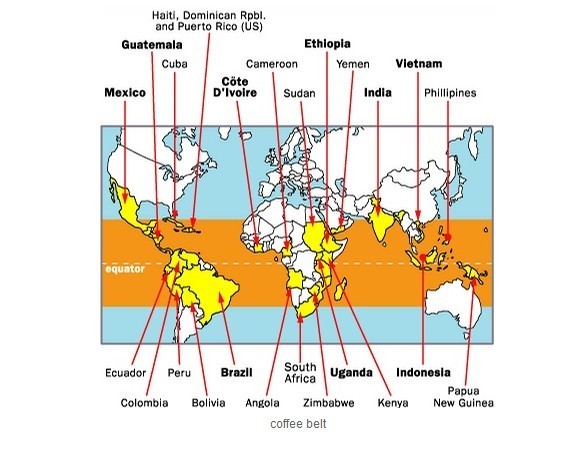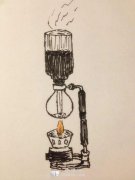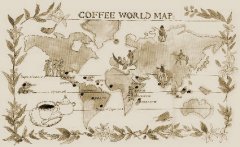Where do good coffee beans come from?

Coffee trees need high altitude, tropical climate and fertile soil to grow the best coffee beans. Such climatic conditions on earth surround the equator, about 25 degrees north latitude to 30 degrees south latitude.
In addition to location, there are many other factors that affect the quality of coffee: planting methods, soil fertility, weather, especially rainfall and light, and exact latitude. The above factors combined with the treatment of raw coffee beans have created the diversity of coffee from different countries and regions in the world. The comprehensive factors are very complex, and there are often differences in quality and flavor in the same plantation.
Coffee grows in more than 50 countries and regions in the world, and here are some of them:
North America and the Caribbean
Hawaii
Although coffee farms are all over the Hawaiian islands, only coffee on KONA Island, the largest island in Hawaii, is famous and in great demand. The MAUNA LOA hillside on the island provides the best natural environment for coffee growth. Coffee tree seedlings are planted in newly formed black volcanic mud as if they were growing on rocks. In the afternoon, tropical clouds naturally form a canopy covered with vegetation, covering the hot sun. Intermittent showers on the island brought just the right amount of rainfall. KONA coffee is carefully crafted into a medium-full coffee with rich taste and rich flavor.
Mexico
Although Mexican coffee is not grown on a large scale, it is made up of small plantations of more than 100000 farmers, making it one of the largest coffee growers in the world. The main plantations are concentrated in the southern provinces formerly known as VERACRUZ,OAXACA and CHIAPAS. A cup of Mexican coffee usually has a strong aroma, with a distinct hint behind the thick taste. Usually these high-quality coffee beans are used for deep roasting and blending. Mexican coffee marked with ALTURA stands for the highlands.
Puerto Rico
Coffee was introduced to Puerto Rico by MARTINIQUE in 1736 and became the world's sixth coffee exporter in the late 19th century. The good times did not last long, and the emergence of hurricanes and other competitors forced Puerto Rico to look for other sources of economic growth. Today, the coffee industry begins to recover again. Fine farming first-class ARABICA grows coffee to produce the highest quality coffee beans. GRAND LARES in the south-central part of the Caribbean Islands and YAUCO SELECTO Island in the southwest are the main and best quality producing areas. It is famous for its taste, balanced acidity and fruity coffee beans.
Central America
Guatemala
Guatemala has been committed to building a coffee industry of higher standards and consistent quality. Guatemala is not famous for its coffee compared with its neighbors in Central and South America. Many people like its unique taste in its rich flavor. ANTIGUA,COBAN and HEUHUETANANGE are the three main coffee producing areas, each with stressful rugged mountains and fertile volcanic soil. Microclimatic conditions determine the quality and flavor of coffee above 4500 feet above sea level. A cup of Guatemalan coffee with a medium to high fullness, a deep spicy taste and a chocolate flavor.
Costa Rica
Coffee from Central America is famous and of high quality. Costa Rica only produces ARABICA beans treated by washing. This kind of bean is moderately full and has a strong sour taste. Baristas often evaluate Costa Rican beans as having a "perfect balance". Coffee is grown in small plantations dominated by FINCAS. After a bumper harvest, raw coffee beans are immediately sent to the National treatment Center (BENEFICIOS) for processing, which is also the birthplace of washing. Intensive farming and high-quality processing have contributed to the high quality of Costa Rican coffee as always.
South America
Colombia
The second largest annual output in the world is a famous coffee producer. Colombia attaches great importance to its reputation and is committed to producing the best coffee. Thousands of family plantations all over the country cultivate first-class coffee beans with a high sense of honor. The unusually rugged terrain provides the best natural environment for coffee cultivation. At the same time, it has also caused historical traffic difficulties from the origin to the port. Even today, donkeys and jeeps are still transported together. Colombian coffee has a soft taste and just the right acidity balance. COLOMBIAN SUPREMO, the highest grade has bright flavor and sweet smell. The EXCELSO grade is softer and the acidity is slightly stronger.
Brazil
There is no doubt that Brazil is the world's largest coffee producer. It seems that the land can be continuously expanded, coffee cultivation occupies a huge amount of land, thousands of people are engaged in coffee-related production, and a large number of coffee is produced. Brazilian coffee is usually soft and is often used alternately by washing and drying. According to the climate, altitude and soil conditions of different areas, two kinds of coffee beans, ARABICA and ROBUSTA, are grown. A good cup of Brazilian coffee is characterized by freshness, sweetness, moderate fullness and low acidity.
Africa and the Middle East
East Africa
Ethiopia
According to coffee legend, the first coffee tree was found in Ethiopia. In fact, it is not difficult to accept that coffee originated here. Today, the coffee beans produced here mainly come from wild coffee forests. It is usually water washing, SIDAMO,HARER and KAFFA, the three main producing areas that carry the reputation of coffee. A cup of Ethiopian coffee is usually rugged, rich in flavor and simple and full in taste.
Kenya
Kenyan coffee is famous and is widely loved in the United States and Europe. A single cup of Kenyan coffee has a distinct sour taste, full of aroma and full taste. Small coffee plantations are hidden in the hills of the Kenyan mountains. Growers put great emphasis on quality. The processing and drying process are very careful and monitored. Kenya has its own unique grading system. AA is the largest coffee bean according to size 10, and AA+ indicates that it is grown on a manor.
West Africa
Ivory Coast
On the west coast of Africa, Ivory Coast is one of the largest producers of ROBUSTA beans in the world. Ivory Coast coffee has a strong aroma, thin taste and light acidity, making it suitable for deep baking for ESPRESSO blending.
the arabian peninsula
Yemen
Yemen is the first country in the world to grow coffee commercially, and you can still find a way to grow coffee from centuries ago. In a small family-based plantation, you can always find a few coffee trees on the terrace of the garden in front of the house. This dry land is short of fresh water, and coffee beans are generally small and irregular in shape. Drying treatment after bumper harvest. Yemeni coffee has a thick and full taste.
In ancient times, coffee was shipped from the Yemeni port of MOCHA to all parts of the world, and MOCHA became synonymous with Arabian coffee. The Dutch mixed Java beans in Arabian coffee, making it the world's first mixed coffee bean-MOCHA JAVA.
Asia
Indonesia
Indonesia is the largest island country in the world with thousands of islands. Several big islands such as SUMATRA, JAVA and SULAWESI (formerly known as CELEBES) are famous for their high-quality coffee. The Dutch colonists brought coffee cultivation here in the 17th century and soon led the world coffee industry. Today, small plantations of 1-2 acres dominate and are mainly treated by drying. Indonesian coffee is famous for its rich and full taste and soft acidity.
Indonesia is also famous for its high-quality old coffee. Traditionally, these coffees are preserved because growers want to sell them at high prices. Proper storage in the warm and humid climate gives these coffees a fuller taste and lighter acidity. This condition is technically impossible to emulate.
Vietnam
Another big coffee country in Asia is Vietnam. Originally French missionaries brought ARABICA coffee trees to the island of BOURBON in the middle of the 19th century and planted them around TONKIN. In modern times, coffee has been reintroduced to Vietnam and the coffee industry has developed rapidly in Vietnam, making it one of the largest producers in the world. Today, ROBUSTA coffee is widely grown in small plantations in southern Vietnam. A cup of Vietnamese coffee has light acidity, moderate fullness and balance. More for mixing.
Important Notice :
前街咖啡 FrontStreet Coffee has moved to new addredd:
FrontStreet Coffee Address: 315,Donghua East Road,GuangZhou
Tel:020 38364473
- Prev

Warm the cup before making coffee
Every time I make coffee, whether it's individual or espresso, I used to warm the cup in advance and put the coffee in a cup with the right temperature, just like putting a couple together. Warming the cup is a simple step, but it is the most indispensable factor in preserving the aroma of a cup of coffee. And warm mood, naturally need to be filled with warm cups.
- Next

Coffee Common sense: the spread of Coffee
People think that Africa is the hometown of coffee. But coffee actually originated in Ethiopia and spread around the world through the Yemeni port of Mocha.
Related
- Beginners will see the "Coffee pull flower" guide!
- What is the difference between ice blog purified milk and ordinary milk coffee?
- Why is the Philippines the largest producer of crops in Liberia?
- For coffee extraction, should the fine powder be retained?
- How does extracted espresso fill pressed powder? How much strength does it take to press the powder?
- How to make jasmine cold extract coffee? Is the jasmine + latte good?
- Will this little toy really make the coffee taste better? How does Lily Drip affect coffee extraction?
- Will the action of slapping the filter cup also affect coffee extraction?
- What's the difference between powder-to-water ratio and powder-to-liquid ratio?
- What is the Ethiopian local species? What does it have to do with Heirloom native species?

